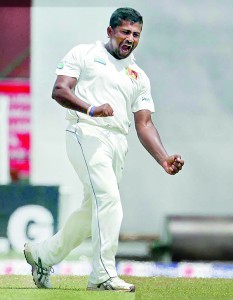Mr. Administrator, what about your priorities?
View(s):In my book there are three types of good cricketers.
The first are the made cricketers who are coached through the fundamentals and polished and come into the showcase of national cricket as good products. But, they have their own limitations, because what is inculcated in them is someone else’s thoughts and directions and as long as they live within those confines they remain as good products. A majority of cricketers belong to this group.
The next lot are born cricketers who, right from the start, show their inherent skills and are more adaptive and receptive to the coaches and absorb what is thrown their way like huge sponges. When they come into the national showcase they are complete products. Most of the times, they even have the inherent leadership qualities because they have the skills of what it takes to be a cricketer. They also have been good students of the game and a have a good balance of the initial guiding and the inborn skills. Most of them go on to captain.
The third group comprises cricketers who are made in heaven. From the time they look at the bat as a tiny tots, they know what it is meant for and by the time they celebrate their first teen birthday, most of the others who are in the circle are talking about them going on to represent their country. The question that looms is not when, but how soon. These cricketers also go through the same fundamentals as the others, but, how they interpret them can be different. They adapt to the coaching their own way and take them in as it suits them. Most of the time, their skills are so much more, but, the skills live within them and they cannot convert the gift into leadership, but, they end up in the folklore not only in their own country, but in the global village.
The third group cricketers come with names such as Sachin Tendulkar, Ian Botham, Kapil Dev and Aravinda de Silva and the list goes on a little bit longer. All four cricketers mentioned went on to captain their countries, but, later settled down to perform under other captains and became legends.
I feel this is one fundamental that we must take as a yardstick. What I say is that all three categories had their institutionalised coaching, but, they blossomed out in different ways. Yet no coach can make one type out of the other; the skills come in accordance with each athlete’s inborn skills and the desire to practise what he has learned.
There is also a great division here: The players who get the proper basics and the players, though having the basic skills to make to the top, do not learn the ABCs of the game like some others do.
Half a century ago, almost the entire infuse into the national grid came from a few elite schools as you call them now. Yet, there was a difference. These few schools which excelled in the game played among a few –may be eight to twelve matches the most for a season — and mostly the persons who guided the schools as coaches had what it took to give out a product of quality.
 It was an era, when a school cricketer who shines above the rest always ends up with national colours. At that time the club cricket was also there. It was a good vehicle, but, in reality, the schools produced more cricketers to the national grid than the club system. Yet, the whole system was intricately intertwined. However, the inbred system had substance because the input had a quality background. More than ninety per cent of the cricketers who pursued cricket after their school careers came from this background where they were taught the proper basics and the proper cricket mannerisms.
It was an era, when a school cricketer who shines above the rest always ends up with national colours. At that time the club cricket was also there. It was a good vehicle, but, in reality, the schools produced more cricketers to the national grid than the club system. Yet, the whole system was intricately intertwined. However, the inbred system had substance because the input had a quality background. More than ninety per cent of the cricketers who pursued cricket after their school careers came from this background where they were taught the proper basics and the proper cricket mannerisms.
The problems began to crop up only after 1981 when the World Cricket body took Sri Lanka as a full partner. At that point cricket began to grow and when Sri Lanka won the Cricket World Cup in 1996 it exploded. It was a time when countries like England, Australia and South Africa set the trend and the game of cricket grew with them. Even India’s game took time to evolve and it evolved so much, when their explosion came with the IPL, the game withstood the vibrations, though it looked otherwise for a very short period.
In Sri Lanka when the game started to grow, the administration was not ready for the intake. They simply did not have the wherewithal to absorb it. At the same time there was another drawback. The bigger schools in the metropolis which sustained the game for a century went through a very significant change. With the opening of the Sri Lankan economy, the day-to-day challenges escalated. The call for qualifications became more intense. The students began to concentrate more on their CIMAs and the other professional careers and only a selected few filtered into the game from these schools.
This had a two pronged effect. The class of cricket in the metropolis began to blip negatively, while the doors opened wide for the other lot who otherwise were the passive contributors. Unless you were Sanath Jayasuriya, a type three cricketer in my book, they could not break into the scene.
Now the cricketers from the outstation with talent began to flow into the national grid. There were scores of them. They had one advantage over their brothers in the metropolis. This was their knock on the heavens door. Their ticket to fame!!
At this point the administration missed a point. They grasped the intake (or were compelled to) with both hands, but did not infuse expertise to the peripheries as required. The result was the outstations produced cricketers, but their ABCs were faulty. The cricketers from the outstations had the time to pursue a career in cricket and the club system needed them — and so did the national grid. But, the products had a lot of polishing to go through.
The other day I heard about a young spinner who made the ‘A’ tour to the West Indies. He had it in him what it takes to make the grade, but, what he did not know were the basics. He did not know how to set his field to his variations. In which trajectories that he must keep his deliveries. In short, he needs a good polishing. With an aging Rangana Herath, this is a luxury that the administration could hardly afford. But, they are compelled to.
Before thinking about setting off on other projects, this is one area where the SLC must focus its attention on. When a cricketer from outstation comes into the next stage, he should be better equipped basically. He should have a better understanding about his future profession and make the maximum. For that, the administration should make sure that the message cascades properly into the system.
At the moment, we get cricketers into the system, but they are not the finished products that we were discussing at the beginning. Why, because the system has been lethargic in concentrating on the right strategies and the right priorities.
Reality is glaring at them. There is no point in introducing new tournaments and more days of playing cricket. First they must understand from where they get their proper input and bury their stash in that project. Only then the old flow of all three catgories would fill in the system once again.
Follow @timesonlinelk
comments powered by Disqus


